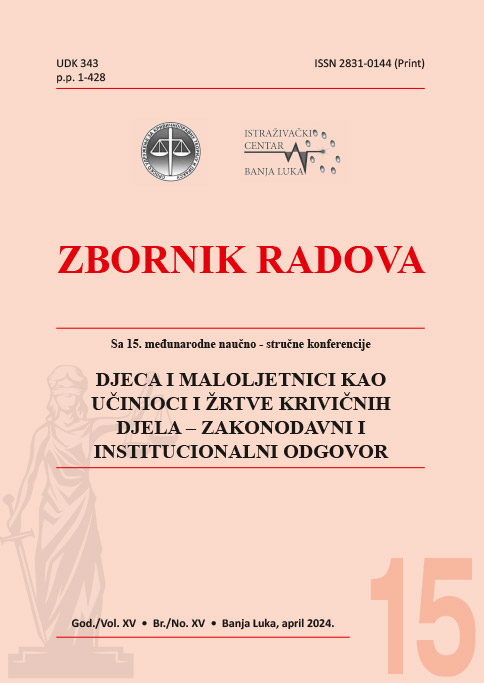THE BASIC FORMS OF CRIMINAL JUSTICE RESPONSE TO JUVENILE DELINQUENCY IN DOCTRINAL AND COMPARATIVE LEGAL PERSPECTIVE
DOI:
https://doi.org/10.7251/CEST1524195SKeywords:
juveniles, children, juvenile delinquency, criminal law, criminal procedural lawAbstract
When individuals from the youngest demographics commit crimes, it always attracts much greater attention and is viewed as a distinct social problem or a legal issue that is consistently under intense scrutiny. This ranges from insignificant newspaper headlines dedicated to specific cases of juvenile delinquency to the conduct of numerous sociological, criminological, psychological and other studies on the phenomenon of juvenile delinquency. Frequently, this leads to harmful sensationalism in the mass media and a kind of superficial trend in academia, regarding theoretical discussions on this form of delinquency. On the other hand, it is logical that both society and the legal system pay increased attention to juvenile delinquency, because its consequences, viewed in the long term, can be potentially very serious, often regardless of the severity of the crime in a particular case.
The beautiful thought that a child is father of the man explains the essence of growing up and maturing, but it also points out the danger that arises when the legal system does not react adequately to juvenile delinquency, as such a "child" then grows into an adult who is far more dangerous to society as a perpetrator of crimes. Consequently, our new "juvenile criminal law" – substantive, procedural and executive, must strive for a delicate balance. It should preserve effective and established norms while also rectifying evident shortcomings and deficiencies.
The classification in the juvenile justice system and forms of basic legal or criminal justice responses to juvenile offenders, based on various models, is not only derived from normative analysis of different criminal systems in comparative law. It also fundamentally arises from certain theoretical concepts found in a range of studies focused on the criminal procedural aspects of juvenile delinquency.
It is crucial to recognize that certain procedural model usually comes with more or less specific substantive legal rules applied to juvenile offenders within that model. This can include varying types of sanctions and measures applied to minors (for instance, mediation is typical for a minimal intervention model, while fines and other "severe" penalties are typical in a non-corrective model). Additionally, there are legal provisions that may encompass not just criminal acts, but also antisocial behavior within a particular juvenile procedure. This feature is particularly notable in the participatory and non-corrective models.
In today's context, juvenile procedure and juvenile justice systems commonly are characterized by the predominance of elements from one of the theoretically conceived models and corresponding elements from one or more other models of juvenile justice. Such is the case with our juvenile justice system, including the substantive and procedural criminal law of Serbia which applies to juvenile offenders. Based on its dominant features, the juvenile justice system in Serbia, including procedures for juveniles, as well as the system of criminal sanctions and the application of other measures, predominantly represents an appropriate combination of protective and justice models. More precisely, according to many of its elements, our system shares significant similarities with a modified judical model across various aspects. This is particularly noticeable because the juvenile procedure is fundamentally structured as a criminal procedure, despite not being formally or terminologically labeled as such. However, it deviates from traditional criminal procedural rules in numerous ways. On the other hand, the mechanisms for applying the principle of prosecutorial discretion are inherently an expression of the principle of minimal intervention, which is the basic characteristic of the minimal intervention model. Moreover, when the decision not to prosecute juvenile offenders or the termination of a previously initiated procedure against them, is conditioned on fulfilling certain obligations related to reconciliation with the victim or involves mediation, our system exibits elements of restorative justice or a restorative model.
